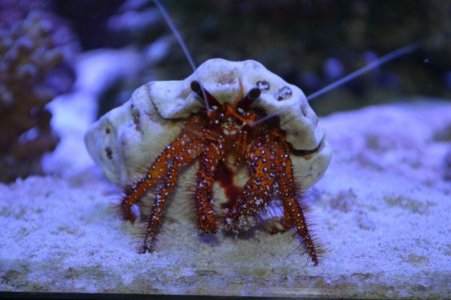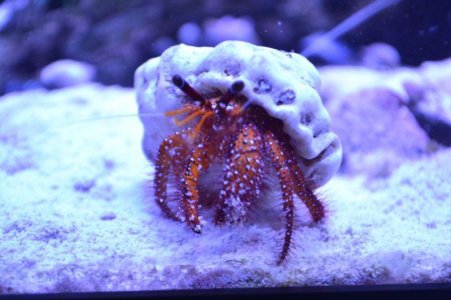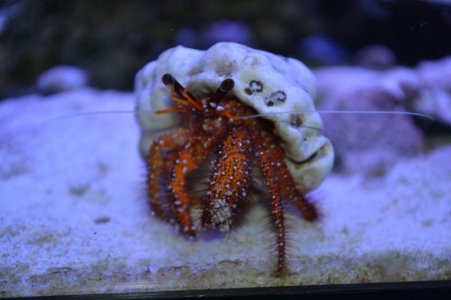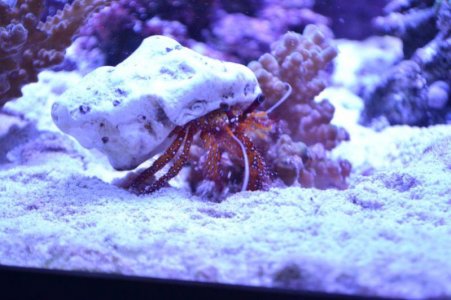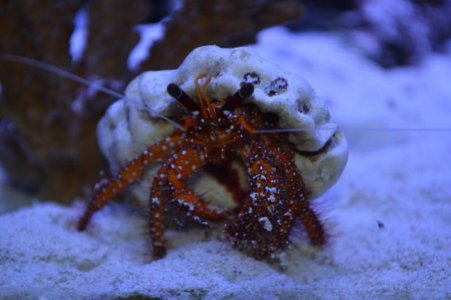Dear friends
I would like to share my bad experience with one wrong sale from a LFS. I asked for the Dwarf Red Tip Hermit Crab and they sold me one White-spotted Hermit Crab (Dardanus megistos). HE IS NOT REEF SAFE. Please see below the pictures of this huge guy.
My particular experience for three days:
First day:
I thought that he was herbivorous, but he is not. He started to walk around the tank, scavenging the sand looking for food. He found out in the foot of my coral some small xenias . He ate them, but I didn't realize on time. After he went to my mini maxi carpet anemone and started to pull the tentacles and tried to cut them to eat without success. Later on he went to my Xenia and started to eat it. It was a big mistake:furious:. I took and put him inside the coast-to-coast overflow. BTW he is very strong.
. He ate them, but I didn't realize on time. After he went to my mini maxi carpet anemone and started to pull the tentacles and tried to cut them to eat without success. Later on he went to my Xenia and started to eat it. It was a big mistake:furious:. I took and put him inside the coast-to-coast overflow. BTW he is very strong.
Second day: I put him back to the tank, and I started to observe his actions. When I saw him to turn round one old mussel shell many time, I thought, let me serve one half fresh mussel shell for this guy. After the shell drop in the water, he ran after it, took and start to devour the mussel. He was starving at all. Some shrimps tried to enjoy, but it was impossible due to the White-spotted aggressiveness. He ate everything and after I gave to him two more pieces of the clam. He ate again. After I saw him calm, maybe to rest after the dinner. It was time to get him back to the overflow.
Third day: In the morning, for my surprise, he was in the tank. I don't know how he got back to the tank, but my first reaction it was in my Xenia. No damage at least. I gave another mussel to see his reaction. The same as before, ran after and started to eat as crazy. For that time I didn't know the real ID for my new friend. After some quick research in the web and forums, I found out and sad surprise. Why sad? Because he is not reef safe. He is beautiful, big, and looks like a monster hehe. I put him now in the sump(refugium). Let see if I can give to him a good life, or I have to look for another sweet home for this "monster" hehe:hmm6:
Some guy has had a good solution putting him in the refugium, and he takes care of him there, far away from the main tank.
I've seen some opinions about him like: "œ"¦very destructive, especially in a reef"¦", "œ"¦He will also attack and eat sleeping fish"¦", ""¦devastator crab is a good description for it (I know...I had one for awhile)"¦".
Some information about this crab:
The White-spotted Hermit Crab (Dardanus megistos) is a large, carnivorous hermit crab. It has hairy red legs covered with white spots with black rims. This hermit will prey on smaller inverts and fish and will not control algae. They are best kept in a species-only tank or a tank with larger fish. The White-spotted Hermit Crab has many other common names and may also be referred to as the Spotted Hermit Crab, Hairy Hermit Crab, Shell-Breaking Reef Hermit or Strawberry Hermit Crab.
Most hermit crabs are scavengers. Some smaller hermit crabs will feed on algae like nuisance hair algae while larger hermit crabs are scavengers and carnivores. Most hermit crabs are opportunistic - they will not actively hunt for a fish or active invertebrates but will prey on sick, dead, or dying individuals. Only the larger hermits like those from the genuses Aniculus, Dardanus, Peguristes, and Petrochirus are a real threat to healthy, larger tankmates or to corals. Calcinus, Clibanarius, and Paguristes are some of the most common "clean-up crew" hermit crabs for algae control and to eat leftover foods and detritus. Hermit crabs that are underfed are also a greater threat to tankmates like snails and other invertebrates.
Hermit Crabs have soft abdomens and use empty snail shells to protect their bodies. As with other crustaceans, hermit crabs must molt to grow. When they molt, they crawl out of their shell homes and shed their own hard shell to grow larger. As they grow larger, they need to find new, larger shells in which to live. Provide extra larger shells in the aquarium for the hermit crabs to move into. Hermit crabs without homes may sometimes make their own by killing the snail inside, or they may molt before they have a new shell, leaving them extremely vulnerable to predators.
Common Name: White-spotted Hermit Crab
Scientific Name: Dardanus megistos
Origin: Indo-Pacific
Aggressiveness: Moderate
Reef Safe: No
Invert Safe: No
Community Safe: No
Difficulty: Easy
Max Size (in inches): 8 (excl. shell)
Min Tank Size (in gallons): 55
pH Range: 8.0-8.4
Temperature Range: 75-82
Specific Gravity Range: 1.022-1.026
Diet: Carnivore, Scavenger
Best Regrads
Bulabr
I would like to share my bad experience with one wrong sale from a LFS. I asked for the Dwarf Red Tip Hermit Crab and they sold me one White-spotted Hermit Crab (Dardanus megistos). HE IS NOT REEF SAFE. Please see below the pictures of this huge guy.
My particular experience for three days:
First day:
I thought that he was herbivorous, but he is not. He started to walk around the tank, scavenging the sand looking for food. He found out in the foot of my coral some small xenias
Second day: I put him back to the tank, and I started to observe his actions. When I saw him to turn round one old mussel shell many time, I thought, let me serve one half fresh mussel shell for this guy. After the shell drop in the water, he ran after it, took and start to devour the mussel. He was starving at all. Some shrimps tried to enjoy, but it was impossible due to the White-spotted aggressiveness. He ate everything and after I gave to him two more pieces of the clam. He ate again. After I saw him calm, maybe to rest after the dinner. It was time to get him back to the overflow.
Third day: In the morning, for my surprise, he was in the tank. I don't know how he got back to the tank, but my first reaction it was in my Xenia. No damage at least. I gave another mussel to see his reaction. The same as before, ran after and started to eat as crazy. For that time I didn't know the real ID for my new friend. After some quick research in the web and forums, I found out and sad surprise. Why sad? Because he is not reef safe. He is beautiful, big, and looks like a monster hehe. I put him now in the sump(refugium). Let see if I can give to him a good life, or I have to look for another sweet home for this "monster" hehe:hmm6:
Some guy has had a good solution putting him in the refugium, and he takes care of him there, far away from the main tank.
I've seen some opinions about him like: "œ"¦very destructive, especially in a reef"¦", "œ"¦He will also attack and eat sleeping fish"¦", ""¦devastator crab is a good description for it (I know...I had one for awhile)"¦".
Some information about this crab:
The White-spotted Hermit Crab (Dardanus megistos) is a large, carnivorous hermit crab. It has hairy red legs covered with white spots with black rims. This hermit will prey on smaller inverts and fish and will not control algae. They are best kept in a species-only tank or a tank with larger fish. The White-spotted Hermit Crab has many other common names and may also be referred to as the Spotted Hermit Crab, Hairy Hermit Crab, Shell-Breaking Reef Hermit or Strawberry Hermit Crab.
Most hermit crabs are scavengers. Some smaller hermit crabs will feed on algae like nuisance hair algae while larger hermit crabs are scavengers and carnivores. Most hermit crabs are opportunistic - they will not actively hunt for a fish or active invertebrates but will prey on sick, dead, or dying individuals. Only the larger hermits like those from the genuses Aniculus, Dardanus, Peguristes, and Petrochirus are a real threat to healthy, larger tankmates or to corals. Calcinus, Clibanarius, and Paguristes are some of the most common "clean-up crew" hermit crabs for algae control and to eat leftover foods and detritus. Hermit crabs that are underfed are also a greater threat to tankmates like snails and other invertebrates.
Hermit Crabs have soft abdomens and use empty snail shells to protect their bodies. As with other crustaceans, hermit crabs must molt to grow. When they molt, they crawl out of their shell homes and shed their own hard shell to grow larger. As they grow larger, they need to find new, larger shells in which to live. Provide extra larger shells in the aquarium for the hermit crabs to move into. Hermit crabs without homes may sometimes make their own by killing the snail inside, or they may molt before they have a new shell, leaving them extremely vulnerable to predators.
Common Name: White-spotted Hermit Crab
Scientific Name: Dardanus megistos
Origin: Indo-Pacific
Aggressiveness: Moderate
Reef Safe: No
Invert Safe: No
Community Safe: No
Difficulty: Easy
Max Size (in inches): 8 (excl. shell)
Min Tank Size (in gallons): 55
pH Range: 8.0-8.4
Temperature Range: 75-82
Specific Gravity Range: 1.022-1.026
Diet: Carnivore, Scavenger
Best Regrads
Bulabr

